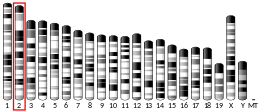LYPD6B
Protein-coding gene in the species Homo sapiens From Wikipedia, the free encyclopedia
LY6/PLAUR Domain Containing 6B, also known under the name Cancer/Testis Antigen 116 (CTA116) and LYPD7 is encoded by the LYPD6B gene.[5] LYPD6B is a member of the lymphocyte antigen 6 (LY6) protein family. It is expressed in the testis, lungs, stomach, prostate and in the nervous system where it acts as a modulator of nicotinic acetylcholine receptor (nAChRs) activity.
| LYPD6B | |||||||||||||||||||||||||||||||
|---|---|---|---|---|---|---|---|---|---|---|---|---|---|---|---|---|---|---|---|---|---|---|---|---|---|---|---|---|---|---|---|
| Identifiers | |||||||||||||||||||||||||||||||
| Aliases | LYPD6B, CT116, LYPD7, LY6/PLAUR domain containing 6B | ||||||||||||||||||||||||||||||
| External IDs | MGI: 1919147; HomoloGene: 12419; GeneCards: LYPD6B; OMA:LYPD6B - orthologs | ||||||||||||||||||||||||||||||
| |||||||||||||||||||||||||||||||
| |||||||||||||||||||||||||||||||
| |||||||||||||||||||||||||||||||
| |||||||||||||||||||||||||||||||
| Wikidata | |||||||||||||||||||||||||||||||
| |||||||||||||||||||||||||||||||
Structure
The protein is 183 amino acids long and its molecular mass is 20.656.[6] The gene LYPD6B encoding the protein is located on chromosome 2 in humans.
As a member of the Ly-6/uPAR family, the protein contains a disulfide β-structural core and three protruding loops.[7]
Background
The protein was discovered for the first time in a 2009 study; its presence was detected in the cytoplasm and it was associated with activation of the AP-1 transcription factor.[8] LYPD6B is known as a prototoxin due to its structural similarity with the 3-fingered snake venom proteins α-bungarotoxin and cobratoxin.[9] As a prototoxin, LYPD6B also belongs to the protein family of Ly-6/urokinase plasminogen activator receptor (Ly6/uPAR). It has a 3-fingered motif secondary structure which appears due to the presence of 8–10 cysteine residues that facilitate disulfide bond formation.[9]
Role
The protein is expressed in the nervous system where it acts as an enhancer of the activity of the neurotransmitter acetylcholine certain α7-containing nicotinic acetylcholine receptors, which have a role in learning.[9] A duplication of the gene has been detected in a case study of two individuals with severe intellectual disability, suggesting its role in proper brain development and cognitive function.[10] Additionally, the protein demonstrates high expression in several other normal organs including the testis, lungs, stomach, and prostate.[11]
Hypermethylation of the gene and a subsequent decreased expression has been demonstrated as one of the contributors to the invasive capacity of cancer cells in melanoma.[12]
The protein LYPD6 also leads to an increase in Wnt/β-catenin signaling.[7]
References
Wikiwand - on
Seamless Wikipedia browsing. On steroids.




